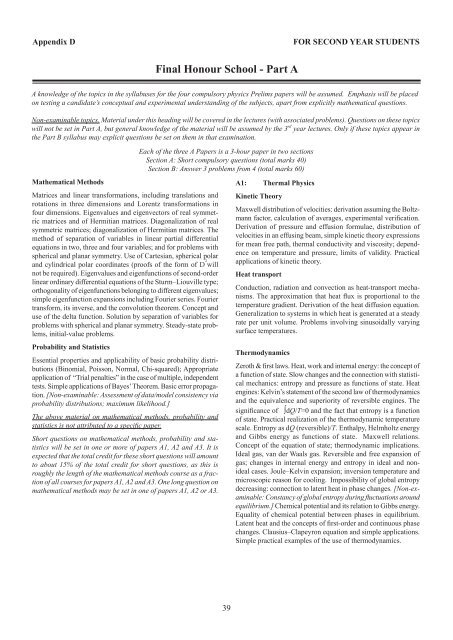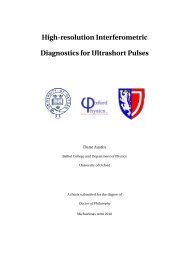OpticsElementary geometrical optics in the paraxial approximation.Refractive index; reflection and refraction at a plane boundaryfrom Huygens’ principle and Fermat’s principle; Snell’s Law; totalinternal reflection. Image formation by reflection at a sphericalboundary; concave and convex mirrors. Real and virtual images.Magnification. Image formation by refraction at a spherical boundaryand by converging and diverging thin lenses. Derivation <strong>of</strong> theexpression for the focal length <strong>of</strong> a thin lens. [Non-examinable:Image formation by systems <strong>of</strong> thin lenses or mirrors as illustratedby: a simple astronomical telescope consisting <strong>of</strong> two convexlenses, a simple reflecting telescope, a simple microscope.]Simple two-slit interference (restricted to slits <strong>of</strong> negligible width).The diffraction grating, its experimental arrangement; conditionsfor proper illumination. The dispersion <strong>of</strong> a diffraction grating.(The multiple-slit interference pattern and the resolution <strong>of</strong> a diffractiongrating are excluded.) Fraunh<strong>of</strong>er diffraction by a singleslit. The resolution <strong>of</strong> a simple lens.Note: the above electromagnetism syllabus is also that for thePhysics and Philosophy Part A paper A2P (Electromagnetism),excluding the sections on Circuit Theory and Optics.CP3: Mathematical Methods 1Differential equations and complex numbersComplex numbers, definitions and operations. The Argand diagram;modulus and argument (phase) and their geometric interpretation;curves in the Argand diagram. De Moivre’s theorem.Elementary functions (polynomial, trigonometric, exponential,hyperbolic, logarithmic) <strong>of</strong> a complex variable. (Complextransformations and complex differentiation and integration areexcluded.)Ordinary differential equations; integrating factors. Second-orderlinear differential equations with constant coefficients; complementaryfunctions and particular integrals. Application to forcedvibrations <strong>of</strong> mechanical or electrical resonant systems, includingthe use <strong>of</strong> a complex displacement variable; critical damping;quality factor (Q), bandwidth, rms, peak and average values.[Physical interpretation <strong>of</strong> complex impedance and power factoris not assumed]Vector algebraAddition <strong>of</strong> vectors, multiplication by a scalar. Basis vectorsand components. Magnitude <strong>of</strong> a vector. Scalar product. Vectorproduct. Triple product. Equations <strong>of</strong> lines, planes, spheres. Usingvectors to find distances.MatricesBasic matrix algebra: addition, multiplication, functions <strong>of</strong> matrices.Transpose and Hermitian conjugate <strong>of</strong> a matrix. Trace, determinant,inverse and rank <strong>of</strong> a matrix. Orthogonal, Hermitian andunitary matrices. Vector spaces in generality. Basis vectors. Scalarproduct. Dual vectors. Linear operators and relation to matrices.Simultaneous linear equations and their solutions. Determination<strong>of</strong> eigenvalues and eigenvectors, characteristic polynomial.Properties <strong>of</strong> eigenvalues and eigenvectors <strong>of</strong> Hermitian linearoperators. Matrix diagonalisation.CP4: Mathematical Methods 2Elementary ideas <strong>of</strong> sequences, series, limits and convergence.(Questions on determining the convergence or otherwise <strong>of</strong> aseries will not be set.) Taylor and MacLaurin series and their applicationto the local approximation <strong>of</strong> a function <strong>of</strong> one variableby a polynomial, and to finding limits. (Knowledge <strong>of</strong> and use <strong>of</strong>the exact form <strong>of</strong> the remainder are excluded.) Differentiation <strong>of</strong>functions <strong>of</strong> one variable including function <strong>of</strong> a function and implicitdifferentiation. Changing variables in a differential equation,integration <strong>of</strong> functions <strong>of</strong> one variable including the methods <strong>of</strong>integration by parts and by change <strong>of</strong> variable, though only simpleuses <strong>of</strong> these techniques will be required, such as ∫xsinx dx and∫xexp(-x 2 ) dx. The relation between integration and differentiation,bi.e. ∫ adx (df/dx) and d/dx(∫ x af(x´) dx´).Differential calculus <strong>of</strong> functions <strong>of</strong> more than one variable. Functions<strong>of</strong> two variables as surfaces. Partial differentiation, chainrule and differentials and their use to evaluate small changes.Simple transformations <strong>of</strong> first order coefficients. (Questions ontransformations <strong>of</strong> higher order coefficients are excluded.) Taylorexpansion for two variables, maxima, minima and saddle points<strong>of</strong> functions <strong>of</strong> two variables.Double integrals and their evaluation by repeated integration inCartesian, plane polar and other specified coordinate systems. Jacobians.Line, surface and volume integrals, evaluation by change<strong>of</strong> variables (Cartesian, plane polar, spherical polar coordinatesand cylindrical coordinates only unless the transformation to beused is specified). Integrals around closed curves and exact differentials.Scalar and vector fields. The operations <strong>of</strong> grad, divand curl and understanding and use <strong>of</strong> identities involving these.The statements <strong>of</strong> the theorems <strong>of</strong> Gauss and Stokes with simpleapplications. Conservative fields.WavesCoupled undamped oscillations in systems with two degrees <strong>of</strong>freedom. Normal frequencies, and amplitude ratios in normalmodes. General solution (for two coupled oscillators) as a superposition<strong>of</strong> modes. Total energy, and individual mode energies.Response to a sinusoidal driving term.Derivation <strong>of</strong> the one-dimensional wave equation and its applicationto transverse waves on a stretched string. D’Alembert’s solution.Sinusoidal solutions and their complex representation. Characteristics<strong>of</strong> wave motion in one dimension: amplitude, phase,frequency, wavelength, wavenumber, phase velocity. Energy ina vibrating string. Travelling waves: energy, power, impedance,reflection and transmission at a boundary. Superposition <strong>of</strong> twowaves <strong>of</strong> different frequencies: beats and elementary discussion <strong>of</strong>construction <strong>of</strong> wave packets; qualitative discussion <strong>of</strong> dispersivemedia; group velocity. Method <strong>of</strong> separation <strong>of</strong> variables for theone-dimensional wave equation; separation constants. Modes <strong>of</strong>a string with fixed end points (standing waves): superposition <strong>of</strong>modes, energy as a sum <strong>of</strong> mode energies.38
Appendix DFOR SECOND YEAR STUDENTSFinal Honour School - Part AA knowledge <strong>of</strong> the topics in the syllabuses for the four compulsory physics Prelims papers will be assumed. Emphasis will be placedon testing a candidate’s conceptual and experimental understanding <strong>of</strong> the subjects, apart from explicitly mathematical questions.Non-examinable topics. Material under this heading will be covered in the lectures (with associated problems). Questions on these topicswill not be set in Part A, but general knowledge <strong>of</strong> the material will be assumed by the 3 rd year lectures. Only if these topics appear inthe Part B syllabus may explicit questions be set on them in that examination.Mathematical MethodsMatrices and linear transformations, including translations androtations in three dimensions and Lorentz transformations infour dimensions. Eigenvalues and eigenvectors <strong>of</strong> real symmetricmatrices and <strong>of</strong> Hermitian matrices. Diagonalization <strong>of</strong> realsymmetric matrices; diagonalization <strong>of</strong> Hermitian matrices. Themethod <strong>of</strong> separation <strong>of</strong> variables in linear partial differentialequations in two, three and four variables; and for problems withspherical and planar symmetry. Use <strong>of</strong> Cartesian, spherical polarand cylindrical polar coordinates (pro<strong>of</strong>s <strong>of</strong> the form <strong>of</strong> D 2 willnot be required). Eigenvalues and eigenfunctions <strong>of</strong> second-orderlinear ordinary differential equations <strong>of</strong> the Sturm–Liouville type;orthogonality <strong>of</strong> eigenfunctions belonging to different eigenvalues;simple eigenfunction expansions including Fourier series. Fouriertransform, its inverse, and the convolution theorem. Concept anduse <strong>of</strong> the delta function. Solution by separation <strong>of</strong> variables forproblems with spherical and planar symmetry. Steady-state problems,initial-value problems.Probability and StatisticsEssential properties and applicability <strong>of</strong> basic probability distributions(Binomial, Poisson, Normal, Chi-squared); Appropriateapplication <strong>of</strong> “Trial penalties” in the case <strong>of</strong> multiple, independenttests. Simple applications <strong>of</strong> Bayes’ Theorem. Basic error propagation.[Non-examinable: Assessment <strong>of</strong> data/model consistency viaprobability distributions; maximum likelihood.]The above material on mathematical methods, probability andstatistics is not attributed to a specific paper.Short questions on mathematical methods, probability and statisticswill be set in one or more <strong>of</strong> papers A1, A2 and A3. It isexpected that the total credit for these short questions will amountto about 15% <strong>of</strong> the total credit for short questions, as this isroughly the length <strong>of</strong> the mathematical methods course as a fraction<strong>of</strong> all courses for papers A1, A2 and A3. One long question onmathematical methods may be set in one <strong>of</strong> papers A1, A2 or A3.Each <strong>of</strong> the three A Papers is a 3-hour paper in two sectionsSection A: Short compulsory questions (total marks 40)Section B: Answer 3 problems from 4 (total marks 60)A1: Thermal PhysicsKinetic TheoryMaxwell distribution <strong>of</strong> velocities: derivation assuming the Boltzmannfactor, calculation <strong>of</strong> averages, experimental verification.Derivation <strong>of</strong> pressure and effusion formulae, distribution <strong>of</strong>velocities in an effusing beam, simple kinetic theory expressionsfor mean free path, thermal conductivity and viscosity; dependenceon temperature and pressure, limits <strong>of</strong> validity. Practicalapplications <strong>of</strong> kinetic theory.Heat transportConduction, radiation and convection as heat-transport mechanisms.The approximation that heat flux is proportional to thetemperature gradient. Derivation <strong>of</strong> the heat diffusion equation.Generalization to systems in which heat is generated at a steadyrate per unit volume. Problems involving sinusoidally varyingsurface temperatures.ThermodynamicsZeroth & first laws. Heat, work and internal energy: the concept <strong>of</strong>a function <strong>of</strong> state. Slow changes and the connection with statisticalmechanics: entropy and pressure as functions <strong>of</strong> state. Heatengines: Kelvin’s statement <strong>of</strong> the second law <strong>of</strong> thermodynamicsand the equivalence and superiority <strong>of</strong> reversible engines. Thesignificance <strong>of</strong> ∫dQ/T=0 and the fact that entropy is a function<strong>of</strong> state. Practical realization <strong>of</strong> the thermodynamic temperaturescale. Entropy as dQ (reversible)/T. Enthalpy, Helmholtz energyand Gibbs energy as functions <strong>of</strong> state. Maxwell relations.Concept <strong>of</strong> the equation <strong>of</strong> state; thermodynamic implications.Ideal gas, van der Waals gas. Reversible and free expansion <strong>of</strong>gas; changes in internal energy and entropy in ideal and nonidealcases. Joule–Kelvin expansion; inversion temperature andmicroscopic reason for cooling. Impossibility <strong>of</strong> global entropydecreasing: connection to latent heat in phase changes. [Non-examinable:Constancy <strong>of</strong> global entropy during fluctuations aroundequilibrium.] Chemical potential and its relation to Gibbs energy.Equality <strong>of</strong> chemical potential between phases in equilibrium.Latent heat and the concepts <strong>of</strong> first-order and continuous phasechanges. Clausius–Clapeyron equation and simple applications.Simple practical examples <strong>of</strong> the use <strong>of</strong> thermodynamics.39









![Extended Notes 8 [pdf]](https://img.yumpu.com/50123548/1/190x245/extended-notes-8-pdf.jpg?quality=85)




![Handout 3 [pdf] - University of Oxford Department of Physics](https://img.yumpu.com/46475432/1/190x245/handout-3-pdf-university-of-oxford-department-of-physics.jpg?quality=85)